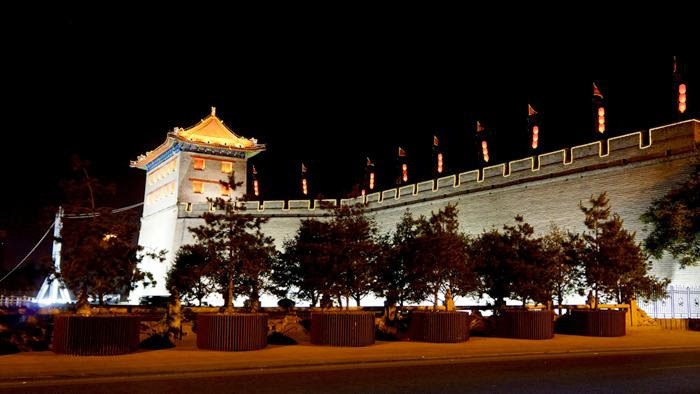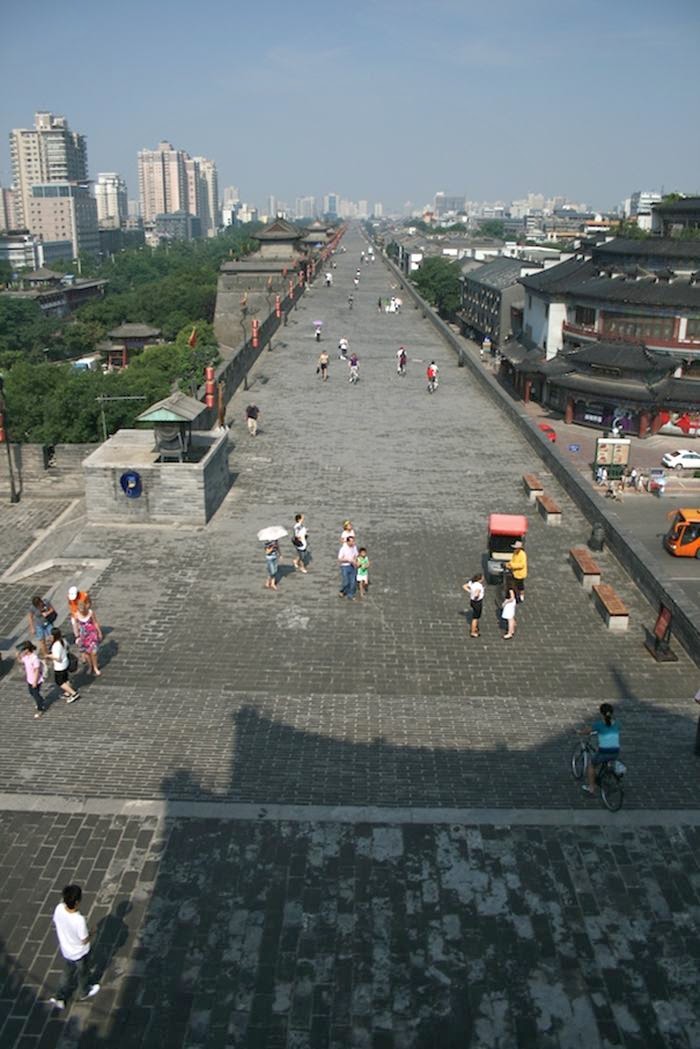Historical Xi'an City Wall 

The first landmark visitors will encounter in Xi'an is the ancient city
wall, which stretches round the old city. The northern side runs
parallel to the railway. Xi'an was originally a walled city, and even
today the wall is considered a landmark dividing the city into the inner
part and the outer part. The city wall is massive - tall, long and
thick. The South Gate and North Gate are the two main entrances to the
inner city. The city itself is neatly arranged along the city wall. Xi'an's city wall, after its enlargement in the Ming Dynasty, stands 12
meters high. It is 12-14 meters across the top, 15-18 meters thick at
bottom, and 13.7 kilometers in length. There is a rampart every 120
meters. The ramparts are towers that extend out from the main wall.
The
ramparts were built to allow soldiers to see enemies trying to climb the
wall. The distance between the ramparts is within the range of arrows
fired from either side. This allowed soldiers to protect the entire wall
without exposing themselves to the enemy. There are altogether 98
ramparts; each has a sentry building on top of it.Above Photo — Link
Historical Xi'an City Wall 

Photo — Link
History — Xi'an City Wall was erected in the 14th century Ming Dynasty,
under the regime of Emperor Zhu Yuanzhang. When Zhu Yuanzhang captured
Huizhou, long before the establishment of the Ming Dynasty, he was
admonished by a hermit named Zhu Sheng, who told him to "build high
walls, store abundant provisions and take your time in proclaiming
yourself emperor." This advice Zhu Yuanzhang heeded. Once the whole
country was unified, he sent orders to the local governments to build
city walls on a large scale. Zhu assured that "out of all the mountains
and rivers in the world, the area of Central Qin is the most strongly
fortified and strategically impregnable." The current city wall is an
enhancement of the old Tang Dynasty structure, as a result of the
emperor's wall building campaign.
Historical Xi'an City Wall 

Photo — Link
The Structure of the City Wall — The first city wall of Xi'an was built
of earth, rammed layer upon layer. The base layer was made of earth,
quick lime, and glutinous rice extract, tamped together. It made the
wall extremely strong and firm. Later, the wall was totally enclosed
with bricks. A moat, wide and deep, ran around the city. Over the moat,
there used to be a huge drawbridge, which would cut off the way in and
out of the city, once lifted.
Historical Xi'an City Wall
Photo — Link
Historical Xi'an City Wall
Photo — Link
Historical Xi'an City Wall
Photo — Link
Historical Xi'an City Wall
Photo — Link
Historical Xi'an City Wall
Photo — Link
Historical Xi'an City Wall
Photo — Link
Battlements — Along the outer crest of the city wall there are
crenellations or battlements. Under each of the 5,984 crenels there is a
square hole, from which arrows were shot and watch was kept. The lower,
inner walls are called parapets. They were used to prevent soldiers
from falling off the wall, when traveling back and forth.
Historical Xi'an City Wall
Photo — Link
Tunnels — The narrow tower and the main tower are connected by tunnels,
in which soldiers could be stationed. From the tunnels there are also
horse passages leading to the top of the wall. There are gradually
ascending steps, made so that it was easy for war horses to ascend and
descend. There are all together 11 horse passages around the city.
Historical Xi'an City Wall
Photo — Link
Historical Xi'an City Wall
Photo — Link
Watch Towers — A watch tower is located on each of the four corners of
the wall. The one at the southwestern corner is round, probably after
the model of the imperial city wall of the Tang Dynasty, but the other
three are square-shaped. On top of the watch towers there is a corner
rampart, higher and larger than the ordinary ramparts. This shows the
strategic importance of the corners of the city wall in war times.
Historical Xi'an City Wall
Photo — Link
Historical Xi'an City Wall
Photo — Link
Historical Xi'an City Wall
Photo — Link
Historical Xi'an City Wall
Photo — Link
Historical Xi'an City Wall
Photo — Link
The Gates — The gates of the city wall were the only way to go into and
out of town. Therefore, these gates were important strategic points,
which the feudal rulers racked their brains to try to defend. In Xi'an's
case, the north, south, east and west gates, each consist of three
towers: the gate tower, which holds the drawbridge, the narrow tower and
the main tower. The gate tower stands proud of the wall. It is used to
lift and lower the drawbridge. The narrow tower is in the middle. Its
inner walls have square windows to shoot arrows from. The main tower is
the innermost one, and forms the entrance to the city.
Historical Xi'an City Wall
Photo — Link
Historical Xi'an City Wall
Photo — Link
Historical Xi'an City Wall
Photo — Link
Historical Xi'an City Wall
Photo — Link
Historical Xi'an City Wall
Photo — Link
Historical Xi'an City Wall
Photo — Link
Historical Xi'an City Wall
Photo — Link
Historical Xi'an City Wall
Photo — Link
Historical Xi'an City Wall
Photo — Link
Historical Xi'an City Wall
Photo — Link
Historical Xi'an City Wall
Photo — Link
Historical Xi'an City Wall
Photo — Link
Historical Xi'an City Wall
Photo — Link
Historical Xi'an City Wall
Photo — Link
Historical Xi'an City Wall
Photo — Link
Historical Xi'an City Wall
Photo — Link
Historical Xi'an City Wall
Photo — Link
Historical Xi'an City Wall
Photo — Link
Historical Xi'an City Wall
Photo — Link
Historical Xi'an City Wall
Photo — Link
Historical Xi'an City Wall
Photo — Link
Historical Xi'an City Wall
Via — Link





































No comments:
Post a Comment
Note: only a member of this blog may post a comment.